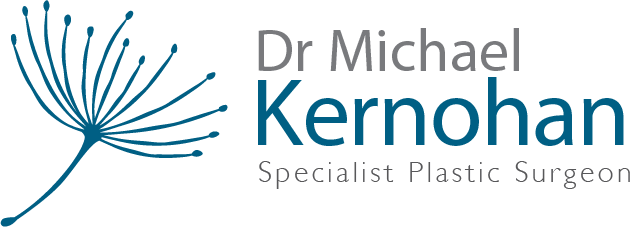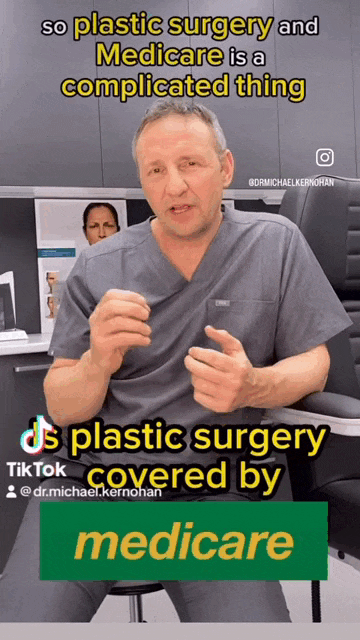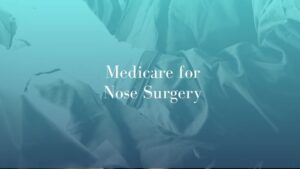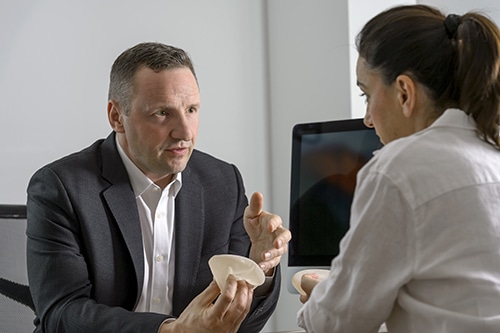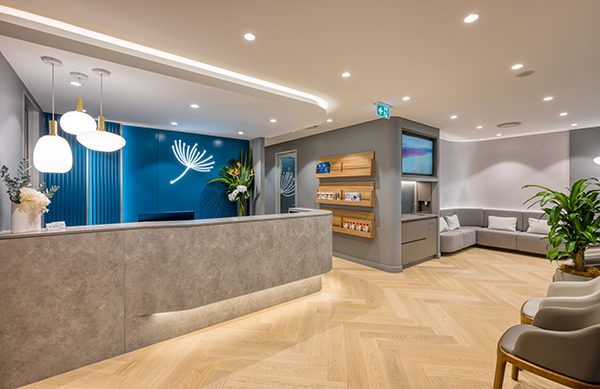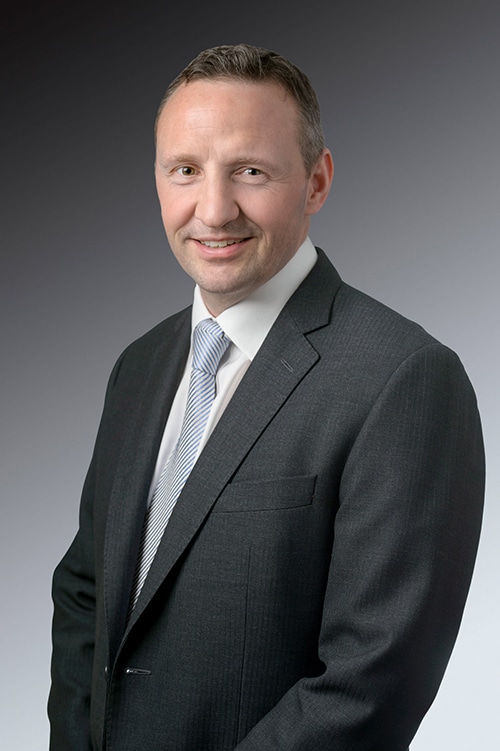Medicare Coverage for Your Rhinoplasty – What You Need to Know
Nose surgery, also known as rhinoplasty, is a common procedure that Australians consider for a variety of reasons. Whether it’s to address a functional issue like breathing difficulties or to make aesthetic changes to the appearance of the nose, rhinoplasty can be an option.
As you explore the possibility of getting a nose job, one of the key questions you’re likely to have is whether Medicare will cover the costs of the procedure. This is an important consideration, as the financial implications can play a significant role in your decision-making process.
The good news is that in certain circumstances, Medicare may provide some coverage for rhinoplasty. However, the specific criteria can be complex and can vary depending on the individual’s medical needs and the nature of the procedure. It’s important to understand the nuances of Medicare’s coverage policies to ensure you make an informed decision about your treatment options and the associated costs.
In this blog post, Specialist Plastic Surgeon Dr Michael Kernohan will get into the details of Medicare’s coverage for nose surgery in Australia. Dr Kernohan will explore the different scenarios where Medicare may provide a rebate, as well as the instances where the procedure may be considered purely cosmetic and, therefore, ineligible for Medicare coverage.
Take the Quiz
Medicare Coverage Basics
Before getting into the specifics of Medicare’s coverage for rhinoplasty, it’s important to have a general understanding of how the Australian Medicare system works and the types of medical procedures it typically covers.
When it comes to medical procedures, Medicare coverage can be broadly divided into two categories: medically necessary and cosmetic. Medically necessary procedures are those that are deemed essential for maintaining or improving an individual’s health and well-being. These procedures are typically covered by Medicare, with the government providing a rebate to offset the costs for the patient.
On the other hand, cosmetic procedures are those that are primarily undertaken for aesthetic reasons, rather than to address a medical need. Such procedures are generally not covered by Medicare, and the patient is responsible for the full cost of the treatment.
It’s important to note that the distinction between medically necessary and cosmetic procedures can sometimes be blurred, particularly in the case of certain surgical procedures like rhinoplasty. In such situations, the Medicare eligibility criteria becomes more nuanced, and the specific circumstances of the individual case must be carefully evaluated.
Rhinoplasty and Medicare Eligibility
When it comes to the question of whether Medicare will cover the cost of your nose surgery, the key factor to consider is the purpose and nature of the procedure. Rhinoplasty can be performed for both medical and cosmetic reasons, and Medicare’s eligibility criteria are largely based on the primary intent of the surgery.
In situations where the rhinoplasty is deemed medically necessary, there is a higher likelihood of Medicare coverage. This can include cases where the procedure is performed to address functional issues, such as a deviated septum or other structural abnormalities that are causing breathing difficulties or other health problems.
For example, if you have a deviated septum that is significantly impacting your ability to breathe normally, Medicare may consider the rhinoplasty surgery necessary to correct this medical condition. In these instances, Medicare may provide a rebate to offset the costs of the procedure, as it is considered a medically necessary treatment.
On the other hand, if the primary purpose of the rhinoplasty is to alter the appearance of your nose for aesthetic reasons, such as changing the shape, size, or profile, Medicare is more likely to view the procedure as purely cosmetic. In these cases, the surgery would not be covered by the public health insurance system, and you would be responsible for the full cost of the treatment.
MBS Item Numbers for Rhinoplasty
· MBS Item Number 41671
Septal surgery, including septoplasty, septal reconstruction, septectomy, closure of septal perforation or other modifications of the septum, not including cauterisation, by any approach, other than a service associated with a service to which item 41689, 41692 or 41693 applies (H)
· MBS Item Number 45632
Rhinoplasty, partial, involving correction of one or both lateral cartilages, one or both alar cartilages or one or both lateral cartilages and alar cartilages, if:
(a) the indication for surgery is:
(i) airway obstruction and the patient has a self reported NOSE Scale score of greater than 45; or
(ii) significant acquired, congenital or developmental deformity; and
(b) photographic and/or NOSE Scale evidence demonstrating the clinical need for this service is documented in the patient notes
· MBS Item Number 45635
Rhinoplasty, partial, involving correction of bony vault only, if:
(a) the indication for surgery is:
(i) airway obstruction and the patient has a self‑reported NOSE Scale score of greater than 45; or
(ii) significant acquired, congenital or developmental deformity; and
(b) photographic and/or NOSE Scale evidence demonstrating the clinical need for this service is documented in the patient notes
· MBS Item Number 45641
Rhinoplasty, total, including correction of all bony and cartilaginous elements of the external nose, with or without autogenous cartilage or bone graft from a local site (nasal), if:
(a) the indication for surgery is:
(i) airway obstruction and the patient has a self‑reported NOSE Scale score of greater than 45; or
(ii) significant acquired, congenital or developmental deformity; and
(b) photographic and/or NOSE Scale evidence demonstrating the clinical need for this service is documented in the patient notes
· MBS Item Number 45644
Rhinoplasty, total, including correction of all bony and cartilaginous elements of the external nose involving autogenous bone or cartilage graft obtained from distant donor site, including obtaining of graft, if:
(a) the indication for surgery is:
(i) airway obstruction and the patient has a self‑reported NOSE Scale score of greater than 45; or
(ii) significant acquired, congenital or developmental deformity; and
(b) photographic and/or NOSE Scale evidence demonstrating the clinical need for this service is documented in the patient notes;
other than a service associated with a service to which item 45718 applies (H)
· MBS Item Number 45650
Rhinoplasty, revision of, if:
(a) the indication for surgery is:
(i) airway obstruction and the patient has a self-reported NOSE Scale score of greater than 45; or
(ii) significant acquired, congenital or developmental deformity; and
(b) photographic and/or NOSE Scale evidence demonstrating the clinical need for this service is documented in the patient notes
Download Dr Kernohan’s Rhinoplasty Nose Surgery Guide
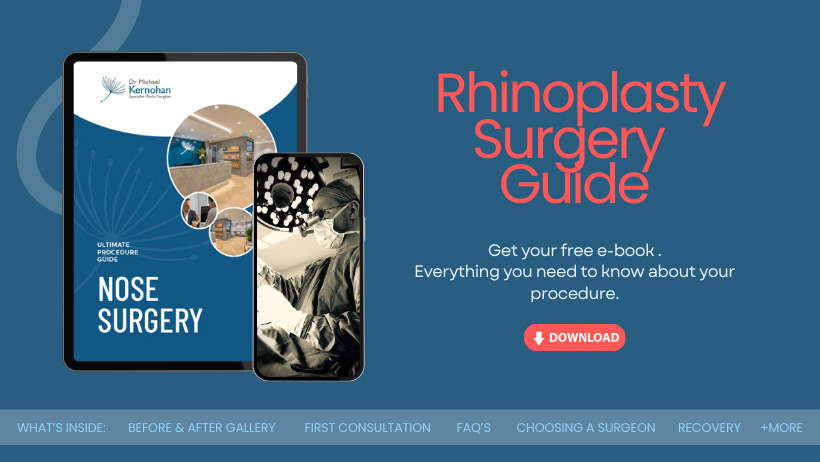
Staying Up-to-Date on Policy Changes
It’s important to note that the policies and guidelines surrounding Medicare coverage for rhinoplasty can be subject to change over time. As the healthcare landscape evolves, the Australian government may update the criteria for what it considers a medically necessary procedure eligible for Medicare rebates.
Therefore, it is essential for patients who are considering nose surgery to stay informed about the latest developments in Medicare’s coverage policies. This will ensure that you have the most accurate and up-to-date information when making decisions about your treatment options and the associated costs.
To stay informed, it is recommended that you regularly check the official Medicare Australia website (www.servicesaustralia.gov.au/medicare) for any updates or changes to the program’s coverage policies. Additionally, you can consult with your healthcare provider, such as your general practitioner or Dr Kernohan who will be performing the rhinoplasty procedure, as they will be well-versed in the current Medicare guidelines and can provide valuable guidance.
Private Health Insurance
In addition to understanding the Medicare coverage for rhinoplasty, it’s also important to consider the role of private health insurance in your treatment plan. While Medicare may provide some coverage for medically necessary nose surgery, private health insurance can play a complementary role in helping to offset the remaining costs.
In Australia, many individuals opt to have private health insurance in addition to the public Medicare system. This private coverage can provide an extra layer of financial protection for a range of medical procedures, including certain types of rhinoplasty.
If you have private health insurance, it’s essential to check with your health fund to determine the extent of coverage they provide for nose surgery. Some private insurers may offer partial or full coverage for rhinoplasty procedures that are deemed medically necessary, such as those addressing breathing difficulties or other functional issues.
To verify your eligibility and coverage details, you should reach out to your private health insurance provider directly. They will be able to inform you of the specific requirements, exclusions, and any potential out-of-pocket expenses you may need to cover. This information will be crucial in helping you understand the overall financial implications of your rhinoplasty procedure and plan your budget accordingly.
Costs of Self-Funded Rhinoplasty in Australia
When exploring the option of self-funding your rhinoplasty (nose surgery) in Australia, it’s important to understand the various factors that can influence the overall cost of the procedure. As a cosmetic surgery not covered by Medicare, the final price tag will depend on several key considerations.
Surgeon’s Fees
The primary driver of the cost will be the fees charged by the plastic surgeon or cosmetic surgeon performing the rhinoplasty. Surgeon fees can vary widely based on their level of experience, qualifications, and the complexity of the procedure required
Anaesthesia and Facility Fees
In addition to the surgeon’s fees, you’ll also need to account for the costs associated with the anaesthesia and the surgical facility where the procedure will be performed. These fees can vary depending on the specific clinic or hospital.
Additional Costs
Other potential expenses to factor in may include:
- Pre-operative consultations and tests
- Post-operative care and follow-up appointments
- Medication and supplies
- Travel and accommodation (if the surgery is not performed locally)
FAQs about Medicare and Nose Surgery

Are there any out-of-pocket costs for Medicare-covered rhinoplasty?
- Yes, there may be additional costs not covered by Medicare, including surgeon’s fees, hospital fees, and anaesthesia. It’s important to check with your surgeon and hospital for a detailed cost estimate.
How can I find out if my specific condition qualifies for Medicare-covered rhinoplasty?
- Consult with your GP and a specialist plastic surgeon who can assess your condition and determine if it meets the criteria for Medicare coverage. They can provide the necessary documentation and referrals.
Does Medicare cover revision rhinoplasty?
- Medicare may cover revision rhinoplasty if it is required due to medical reasons, such as correcting breathing issues or resolving complications from a previous surgery.
Is a pre-authorisation required from Medicare for rhinoplasty?
- While Medicare does not typically require pre-authorisation, it is important to have all necessary documentation and referrals in place before the surgery to ensure coverage.
Further Reading about Rhinoplasty with Sydney Specialist Plastic Surgeon Dr Michael Kernohan
- Read more about Rhinoplasty Nose Surgery NSW
- Read more about How to Make Your Nose Smaller
- Read more about Types of Nose Shapes and Nose Jobs
- Read more about What is a Bulbous Nose? – Nose Surgery Options
- Read more about Cartilage Graft Nose Job
Medical References about Rhinoplasty
- Rhinoplasty – Mayo Clinic
- Risks and complications in rhinoplasty – PubMed
- Rhinoplasty Surgery (Nose Job) – WebMD
- Rhinoplasty: Surgery, Recovery, Before & After – Cleveland Clinic
